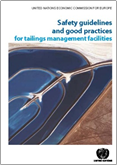
Raising Knowledge among Students and Teachers on Tailings Safety
and its Legislative Review in Ukraine
�
UNECE Safety Guidelines and Good Practices for Tailings Management Facilities (a document review)
The guidelines were developed by the Joint Expert Group on Water and Industrial Accidents, with the support of the United Nations Economic Commission for Europe (ECE) secretariat. The Joint Expert Group was co-chaired by Mr. Gerhard Winkelmann-Oei (Germany) and Mr. Peter Kovacs (Hungary). The resulting guidelines were endorsed by the Conference of the Parties to the Industrial Accidents Convention at its fifth meeting (Geneva, 25�27 November 2008) and by the Meeting of the Parties to the Water Convention at its fifth session (Geneva, 10�12 November 2009). Both bodies encouraged Parties and other ECE member States to disseminate the guidelines for use by the appropriate authorities.
|

|
The document includes three parts, references and terminology. First part (Part A) includes introduction, safety principles for tailings management facilities, and recommendations to member countries, competent authorities, and tailings management facility operators. Second part (Part B) deals with technical and organizational aspects such as pre-construction and construction, operation and management (including education and training of personnel and inspectors), facility inspections, identification, assessment and management of abandoned sites, internal and external emergency planning. Third part (Part C) includes references to international documentation on mining and tailings issues.
|
These guidelines constitute a minimum set of requirements to ensure a basic level of safety for TMFs. They highlight aspects to be considered to achieve an acceptable level of safety through applying different policies, measures and methodologies. Nevertheless, owners and operators are encouraged to apply additional procedures and safeguards in accordance with local assessments to achieve the highest practical level of performance of their TMF. Within this framework the document gives the policy, administrative and legal recommendations to ECE member countries, competent authorities and TMF operators.
The basic principles of TMF operational safety can be summarized as follows.
1.���� The operators of TMFs have the primary responsibility for ensuring the safety of TMFs.
2.���� TMFs should be planned, constructed, operated and closed applying a case-by-case or site-by-site approach.
3.���� Only competent and properly certified personnel should be engaged in the planning, design, construction, operation/management and closure of TMFs.
4.���� A systematic approach to managing TMF safety �planning-construction-operation-closure- rehabilitation� should be acknowledged all cases.
5.���� Understanding of processes in the life cycle of a TMF should be developed at the planning and design stage of the TMF.
The document requires that the Environmental Impact Assessment (EIA) should address location criteria, tailings criteria, site criteria, management: closure, and evaluation of �zero� option/non-implementation of the project; the EIA should include such stages as hazard identification, accident scenarios, identification of potential receptors, safety measures, impact assessment, risk assessment and evaluation. While planning and designing a safe TMF, particular attention should be directed to the tailings pond and the tailings dam.
The TMF should be operated and managed on the basis of an operation and management plan (operation manual) and waste management plan. The operation manual should contain a description of the tailings delivery system, all monitoring procedures/mechanisms for inspection, procedures for reporting on non-compliance and failures; corrective actions to be applied in the event of non-compliance, an internal emergency plan.
The adequate skills of the personnel need to be built through training programmes and on-site experience.
During the inspection, the inspectors should verify in particular if the TMF is managed in accordance with the applicable legal and regulatory standards, as well as with the approved operation manual and waste management plan. Specific guidelines for TMF inspection cover the phases of pre-construction and construction, operation, closure and after closure.
Abandoned or orphaned sites should be regularly inspected by the competent authorities depending on the risk posed by the site. The screening should include a walkover survey concentrating on the containment dam, the beach, the water management system and the hydrographic catchment area, as well as the vulnerability factors for nearby or downstream communities and land use.
The management system for abandoned or orphaned sites should include the organizational structure (competent authorities) with allocation of responsibilities, procedures and resources for accident prevention, identification and evaluation of hazardous sites, monitoring and maintenance of the sites.
The emergency plans should evaluate downstream inundation hazards resulting from floods or dam failure, and upstream conditions that might result from major land displacements or increased flood flows. Internal emergency plans developed by the operator should contain estimations of the amounts and types of equipment needed to deal with polluting or dangerous releases, as well as the construction materials and equipment needed for emergency repairs of the TMF. External emergency plans should be prepared and implemented by the relevant authorities, conform to local needs and vary in accordance with the type and degree of occupancy of the potentially affected area. The local community should be given the opportunity to participate in the preparation and revision of the external emergency plans.
At the time being, �Safety guidelines and good practices for tailings management facilities� by UNECE is the most systematic document among the others in the relevant international legal framework. The document forms a efficient approach to ensure a minimum level of TMF safety to prevent accidents, especially on tailing dams and reduce the negative impact of these facilities on the environment, health and infrastructure.
After the adoption of this document the necessity to develop a TMF checklist that would contain a comprehensive methodology of evaluation of these facilities, a set of measures to improve their safety, and recommendations for inspection and monitoring of facilities, taking into account the TMF status and stages of their life cycle. This checklist should be based on a common approach to the safety evaluation of tailings as complex geotechnical systems and contain a catalogue of proven measures of best available techniques used in the mining industry and in environment restoration. Implementation of these provisions can be achieved through the checklist method.